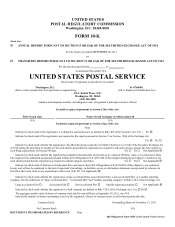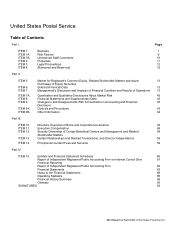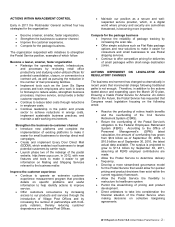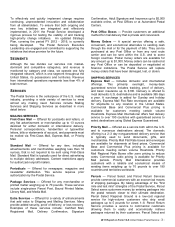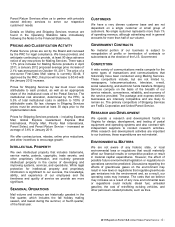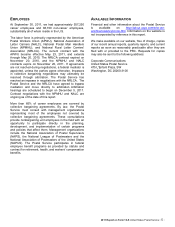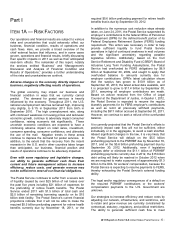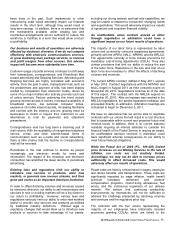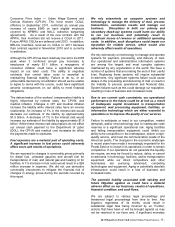US Postal Service 2011 Annual Report Download - page 9
Download and view the complete annual report
Please find page 9 of the 2011 US Postal Service annual report below. You can navigate through the pages in the report by either clicking on the pages listed below, or by using the keyword search tool below to find specific information within the annual report.2011 Report on Form 10-K United States Postal Service - 7 -
obligations is also substantially dependent on the
continuance, strength, and speed of the economic
recovery and the execution of operational strategies
available under current law to increase efficiency and
generate incremental revenue.
Even if legislation is enacted to address shorter-term
liquidity matters such as the PSRHBF prefunding
payment schedule and FERS overfunding, the Postal
Service will continue to face financial stability concerns.
While management continues to take action to improve
the Postal Service’s overall financial situation, the outlook
continues to show the financial necessity for additional
changes. There is an urgent need for additional
legislative changes on multiple issues, including finding a
long-term solution to the current PSRHBF prefunding
schedule, refunding the FERS surplus, permitting a
change in delivery frequency, allowing a restructuring of
existing healthcare benefits programs, and the
development of a more streamlined governance model
for both products and pricing.
Even if these regulatory and legislative changes are
enacted, there is no assurance that those changes will
occur in time to favorably impact 2012, or at all.
We will continue to inform Congress and other
stakeholders of our financial condition and outlook and
pursue legislative changes, cost reductions, and
additional ways to generate revenues that would help
ensure the availability of adequate cash at the end of
2012. Although the Postal Service’s cost-reduction and
revenue-generation initiatives are expected to positively
impact cash flow, we project that they will not, in the
aggregate, be sufficient to offset the expected November
18, 2011, or September 30, 2012, cash shortfalls. Many of
the structural reforms needed to ensure long-term
viability, such as adjustments to the PSRHBF prefunding
payment schedule, can only be achieved with legislative
change. There can be no assurance that Congress will
enact additional legislation that impacts 2012 or future
years.
We are subject to Congressional oversight and
regulation by the Postal Regulatory Commission and
other government agencies. We have a wide variety of
stakeholders whose interests and needs are
sometimes in conflict.
This is an outgrowth of our unique status as a provider of
a fundamental service to the American people. We
attempt to balance the interests of all parties. Efforts to be
responsive to various stakeholders sometimes adversely
impact the speed with which we are able to respond to
changes in mail volume or other operational needs. Any
limitations on our ability to take management action could
adversely affect operating and financial results.
Adverse events may call into question our reputation
for quality, reliability or our ability to deliver the mail,
and could diminish the value of the Postal Service
brand. This could potentially adversely affect our
revenues and results of operations.
We serve almost every American household and business
six days a week. As of their latest survey, and for six
consecutive surveys, the Ponemon Institute named the
Postal Service the most trusted government agency. This
clearly demonstrates that Americans continue to trust and
depend on us. The Postal Service brand represents
quality and reliable service and therefore is a valuable
government asset. We use our brand extensively in sales
and marketing initiatives and take care to defend and
protect it.
Recent events regarding our financial condition and our
plans to study certain postal facilities for potential closure
have been highly publicized. Both Congress and the
Administration have offered various proposals to solve
some of the complex issues affecting the Postal Service.
Although the approaches of various legislators and the
Administration often differ, and there is a lack of
consensus in many areas, the intent of all stakeholders is
the same – to preserve the Postal Service and improve its
overall financial health. Reports in the press regarding
these discussions may result in confusion or
misunderstanding by our customers regarding the future
viability of the Postal Service. As a result, there is a
possibility that customers may change their buying habits
based upon these misperceptions.
Any event, whether real or perceived, that calls into
question our ability to deliver mail, our quality, or our
reliability could diminish the value of our brand and
reputation and could adversely affect our business
operations and operating results.
Our need to restructure our operations in response to
declining mail volumes may result in significant
costs. It is possible that the measures being
considered may be insufficient to reduce our
workforce and physical infrastructure to a level
commensurate with lower and declining mail
volumes.
Our current restructuring plans include studies to evaluate
the potential closure or consolidation of mail processing
operations, retail units, Post Offices, and other facilities
and significantly decrease the number of employees. At
the current time, our regular review of the carrying value
of our assets has not resulted in significant impairments of
our physical assets. However, future changes in business
strategy, legislation, government regulations, or economic
or market conditions may result in material impairment
write-downs of our assets. In addition, we may in the
future consider offering financial incentives to encourage
employees to voluntarily leave the Postal Service, as has

